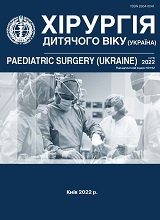Experimental study of bone tissue density in patients with congenital pseudarthrosis of the tibia bones before and after surgery according to computer tomography data
DOI:
https://doi.org/10.15574/PS.2022.76.59Keywords:
children, congenital pseudoarthrosis, bone tissue, densityAbstract
Surgical treatment of congenital pseudarthrosis of the tibia bones is accompanied by a significant percentage of complications and refractions. One of the main reasons for the unsatisfactory results of treatment is the violation of the quality of bone tissue in the area of pseudoarthrosis, which is an obstacle to the normal process of fusion of the shin bones.
Рurpose - use computed tomography to examine bone density in patients with congenital pseudoarthrosis of the tibia before and after surgery.
Materials and methods. CT scans of the tibia of three patients with congenital pseudoarthrosis of the tibia, aged 5 to 7 years. The density in the Hounsfield units of the cortical layer above and below the nonunion zone was determined.
Results. Prior to treatment, a significant decrease (p=0.001) in the density of the cortical layer of the tibia of the injured limb along its entire length was determined. One year after surgery, a statistically significant difference in the density of the cortical layer of the tibia remains.
The optical density of the cortical layer of the damaged tibia is statistically significantly less than healthy (p=0.001). One year after surgical treatment by osteosynthesis with an intramedullary rod with axial mobility, the difference in the density of the cortical layer of the tibia of the healthy and operated limbs remains statistically significant (p=0.001) less than the bone density of the healthy limb. On the unoperated limb, a significant (p<0.05) increase in optical density of bones was observed in all studied areas.
Conclusions. As a result of surgical treatment of congenital pseudoarthrosis of the tibia, there is a statistically significant increase in the density of the cortical layer. The density of the cortical layer of the bones of the operated shin a year after surgery is close to the density of the bones of a healthy limb. The increase in bone density of the operated limb is due not only to the growth of patients, but also occurs due to the possibility of loading the operated limb.
The research was carried out in accordance with the principles of the Helsinki Declaration. The study protocol was approved by the Local Ethics Committee of the participating institution. The informed consent of the patient was obtained for conducting the studies.
No conflict of interests was declared by the authors.
References
Agrawal U, Tiwari V. (2022). Congenital Tibial Pseudarthrosis. Treasure Island (FL): StatPearls Publishing.
Aydin Ozturk P, Arac E, Ozturk U, Arac S. (2021). Estimation of bone mineral density with hounsfield unit measurement. Br J Neurosurg. 25: 1-4. https://doi.org/10.1080/02688697.2021.1888877; PMid:33629886
Everitt BS, Skrondal A. (2010). The Cambridge Dictionary of Statistics. Ed. 4. Cambridge University Press: 480. https://doi.org/10.1017/CBO9780511779633
Guk YM, Zyma AM, Kincha-Polishchuk TA, Chewerda AI et al.(2021). The results of complex treatment of patients with Jaffe-Campanacci syndrome. Paediatric Surgery.Ukraine. 3(72):69-75. https://doi.org/10.15574/PS.2021.72.69.
Jäger M, Wassenaar D, Busch A, Haversath M. (2020). Pseudarthrosen. Orthopade. 49 (6): 547-560. German. https://doi.org/10.1007/s00132-020-03920-w; PMid:32399741
Lippross S, Tsaknakis K, Lorenz HM, Hell AK. (2021). Kongenitale Pseudarthrose der Tibia: Ein seltenes, oft unterschätztes Krankheitsbild [Congenital pseudarthrosis of the tibia : A rare often underestimated disorder]. Unfallchirurg. 124 (9): 755-767. German. https://doi.org/10.1007/s00113-021-01061-z; PMid:34398278
Qu H, Zhuang Y, Zhu L, Zhao Z, Wang K. (2021). The effects of vasoactive intestinal peptide on RANKL-induced osteoclast formation. Ann Transl Med. 9 (2): 127. https://doi.org/10.21037/atm-20-7607; PMid:33569429 PMCid:PMC7867916
Shabtai L, Ezra E, Wientroub S, Segev E. (2015). Congenital tibial pseudarthrosis, changes in treatment protocol. J Pediatr Orthop B. 24 (5): 444-449. https://doi.org/10.1097/BPB.0000000000000191; PMid:25932825
Shah H, Joseph B, Nair BVS, Kotian DB, Choi IH, Richards BS, Johnston C, Madhuri V, Dobbs MB, Dahl M. (2018). What Factors Influence Union and Refracture of Congenital Pseudarthrosis of the Tibia? A Multicenter Long-term Study. J. Pediatric Orthop. 38: e332-e337. https://doi.org/10.1097/BPO.0000000000001172; PMid:29664876
Shannon CE, Huser AJ, Paley D. (2021). Cross-Union Surgery for Congenital Pseudarthrosis of the Tibia. Children (Basel). 8 (7): 547. https://doi.org/10.3390/children8070547; PMid:34202921 PMCid:PMC8303361
Downloads
Published
Issue
Section
License
Copyright (c) 2022 Paediatric Surgery (Ukraine)

This work is licensed under a Creative Commons Attribution-NonCommercial 4.0 International License.
The policy of the Journal “PAEDIATRIC SURGERY. UKRAINE” is compatible with the vast majority of funders' of open access and self-archiving policies. The journal provides immediate open access route being convinced that everyone – not only scientists - can benefit from research results, and publishes articles exclusively under open access distribution, with a Creative Commons Attribution-Noncommercial 4.0 international license(СС BY-NC).
Authors transfer the copyright to the Journal “PAEDIATRIC SURGERY.UKRAINE” when the manuscript is accepted for publication. Authors declare that this manuscript has not been published nor is under simultaneous consideration for publication elsewhere. After publication, the articles become freely available on-line to the public.
Readers have the right to use, distribute, and reproduce articles in any medium, provided the articles and the journal are properly cited.
The use of published materials for commercial purposes is strongly prohibited.

